Medmerry Surveys 2023 2023 - 10th Year of Surveys at Medmerry ALL surveys (approx. 2 hours in length) will start at 13:00 PROMPT on specified Thursdays, meeting at the RSPB Earnley Car Park at Grid Ref SZ 816 968 and then car sharing either to 1) Easton Lane for the 2 Plant Surveys and the Grasshopper Survey or along the track to the pools for the Dragonfly Surveys (Little walking required on any date.) See Main Events List for more information. Sessions are open to all, no matter what your level of expertise, as guidance will be provided. We shall use the Society’s equipment but hand magnifiers, binoculars and reference books will be useful. Any questions or if help required with transport then please contact Philippa Arnott on philippa.arnott@uwclub.net or phone 01243 575345.
Medmerry Survey – Late Dragonflies 7 September 2023The afternoon was hot and sunny though somewhat hazy. A light breeze kept the temperature, which was about 26 C, bearable. We had high hopes of seeing many dragonflies and, sure enough, there were plenty of Migrant hawkers about and we counted at least 12. As they were constantly on the move it was tricky to be sure that we were not counting any more than once. However, for recording purposes, there were definitely between 6 and 20 making them a Code C. There were also a couple of Common darters seen. A Southern hawker made an appearance looking beautiful in the sunshine. The final species seen was a lone Emperor. We were very glad to see one as they used to be much more common on our surveys. They seem to have had a bad year.
As it was so hot and the surveyors were beginning to wilt we finished slightly early, though the last stretch of our route had produced no animals so it was not worth spending more time there. The area was quite dry with well-grown vegetation so not a lot of open water. The pool beyond the ditch was almost dry with just a little water in it. It was generally thought the habitat for dragonflies was not as good as it had been.
Yellow wagtails were spotted flying over and a Common sandpiper was spotted on the mud at the edge of the pool. Marsh frogs were heard at the pool by the Marsh Barn Junction and several froglets were spotted amongst the grasshoppers in the vegetation. A few white butterflies were also seen.
The team then went to Russells Garden Centre café to enjoy a tea to celebrate the end of another successful year of surveys – our 10th! Adam Taylor came to join in the celebrations and he was warmly welcomed. Adam had been Warden at Medmerry for the last few years and was now Site Manager but continues his interest in the CNHS surveys.
Philippa Arnott 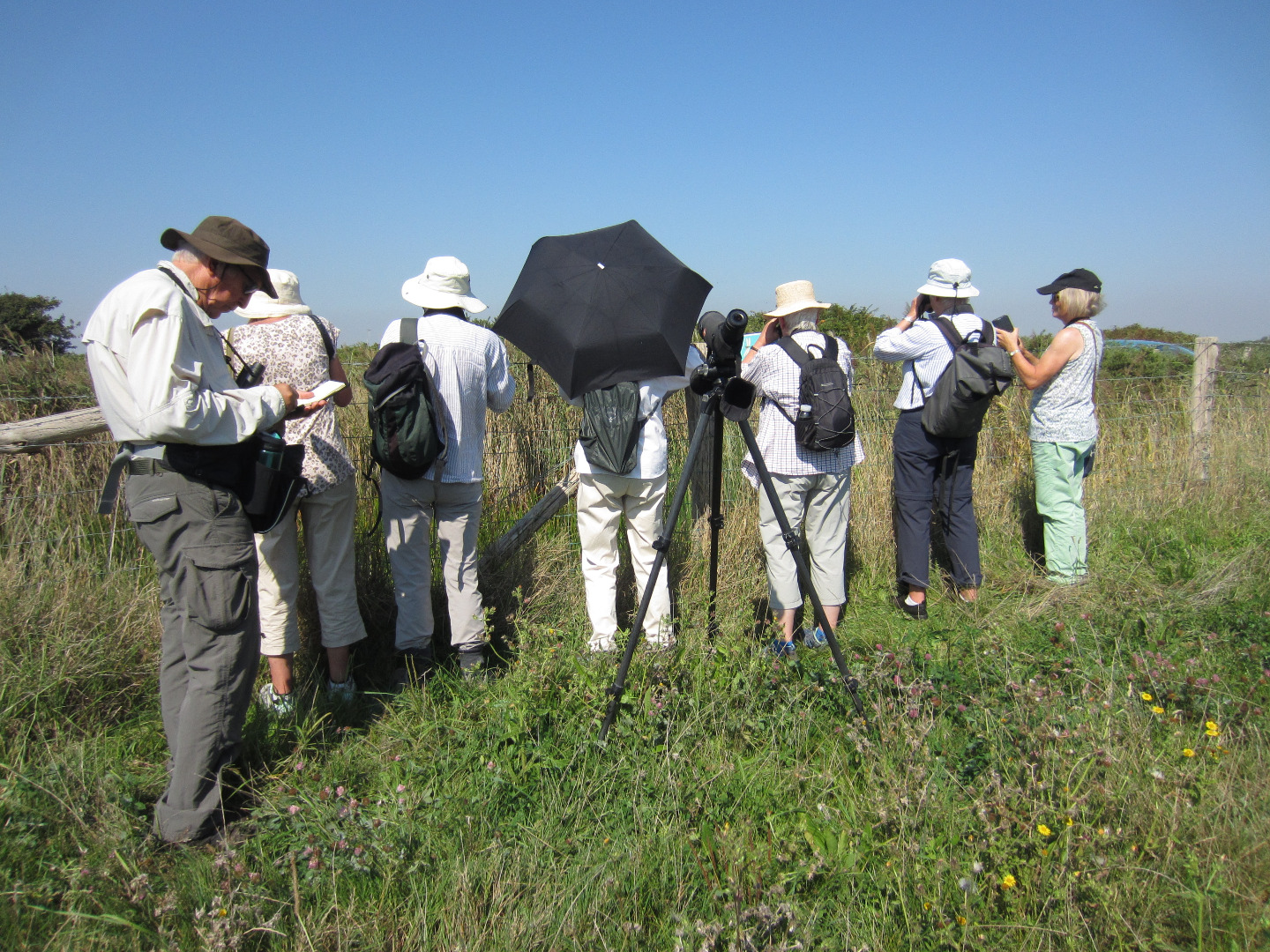 Surveyors on a hot day 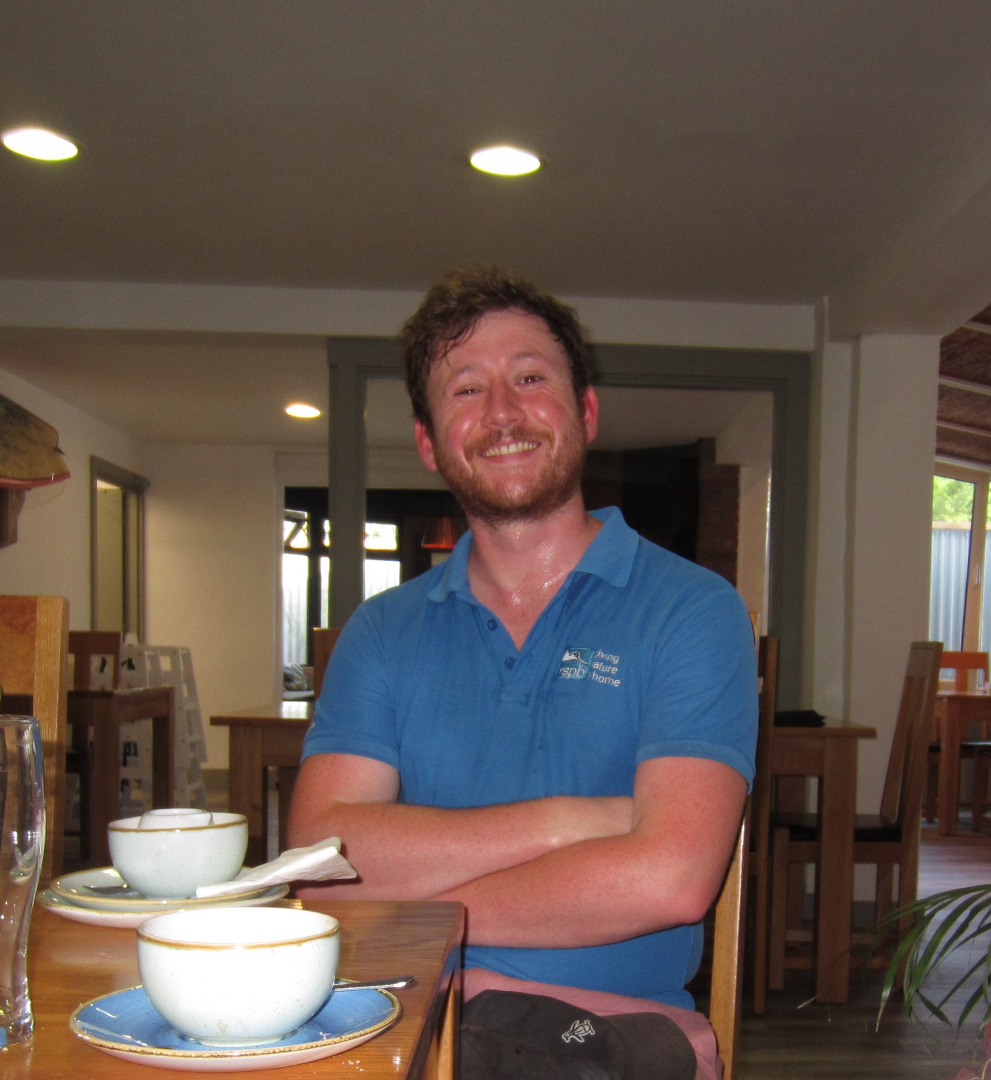 Adam Taylor, RSPB Solent Reserves Manager, joined us for tea. 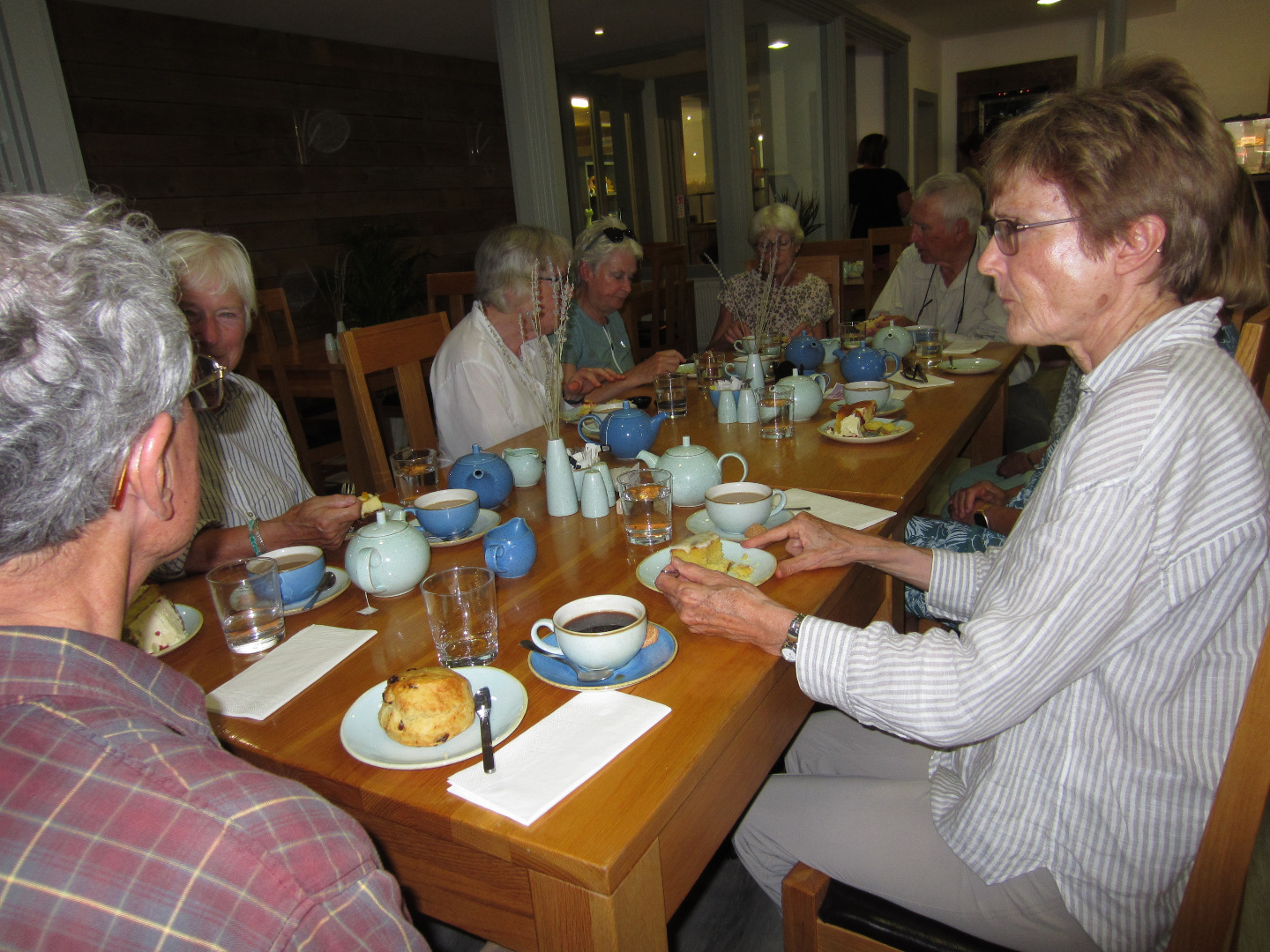
Medmerry Survey – Grasshoppers and Crickets 3 August 2023It was a very pleasant afternoon for the grasshopper survey. Warm, mostly sunny with a light breeze. What a contrast to the previous day when we had gloom and persistent rain! Nine members met with John Arnott to put into practice what we had learned at the workshop the previous week. John had explained how to use bat detectors to listen to and identify the songs of grasshoppers and bush-crickets. We started in the usual way, using sweep nets and pots, and were pleased to see that the vegetation was in much better condition than it had been during last year’s drought. As there had been a lot of recent rain the plants were not so dry and brittle and it was much easier to wield the nets without getting entangled while any captured animal escaped. Surveyors split into pairs sharing a net and dispersed along the site with pots to catch animals that were caught. These were then brought back to the base and identified before being released. The total caught this way was:
Meadow Grasshopper 3 male
Lesser Marsh Grasshopper 12 female
Roesel’s Bush-cricket 1 male
We then progressed to learning how to use the bat detectors (for those who did not attend the workshop). Setting off in a group it became obvious that there were many individuals of species that had not been caught in the nets. It was quite challenging learning to recognise the different songs but after a while the surveyors were able to identify the most commonly heard species and were becoming more confident. Those identified this way were recorded using the scale of estimated numbers from the Grasshoppers form on the iRecord website:
Roesel’s Bush-cricket E 20-49
Long-winged Conehead D 10-19
Lesser Marsh Grasshopper C 6-9
Meadow Grasshopper D 10-19
Other wildlife
3 Common blue butterflies were observed flitting over the site. A female Wasp spider was found. A solitary Meadow brown butterfly and a lone Small/Essex skipper were seen. Bumblebees included Red-tailed, Buff-tailed and Common carder. Linnets were heard and a large dragonfly flew past me so quickly I had no chance of identifying it but it was probably an Emperor from the size of it. Several ladybirds were noted which were pleasing to see.
John would like to draw your attention to this email he received on the evening of 3rd August:
“ iRecord Grasshoppers is due to be updated and until then, whilst the app is still available for identification help, it is unfortunately not possible to log on to it or add records through the app.
Instead, you can use the same account to log into the general iRecord app, where you can import your records. Alternatively, you could use the Grasshopper recording form on the iRecord website, which would allow you to include sound files: https://irecord.org.uk/enter-grasshopper-records.”
Thanks to the surveyors for all the hard work they put in. It was an extremely interesting and useful afternoon.
Philippa Arnott
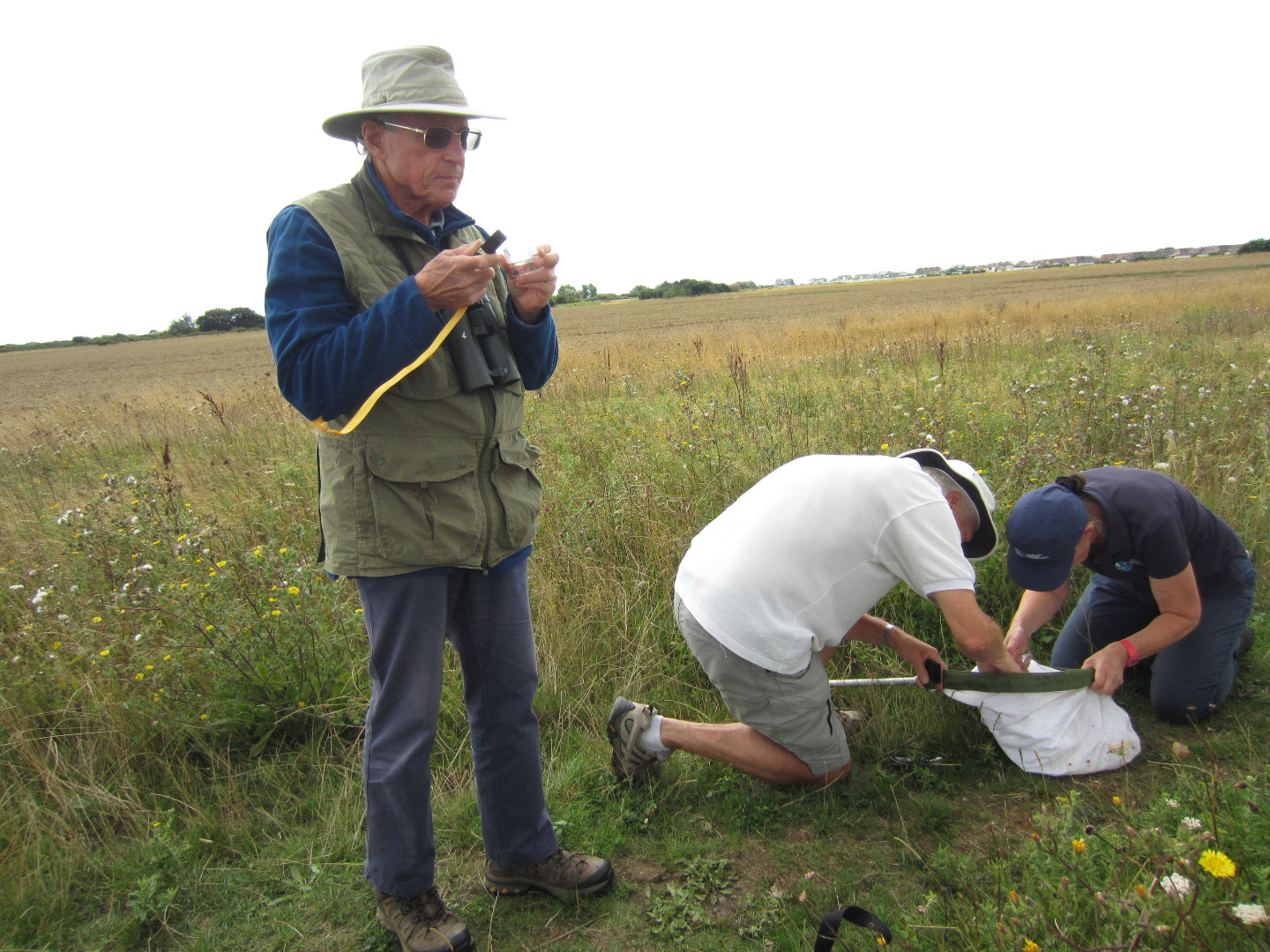 John Arnott and ChiNATS members 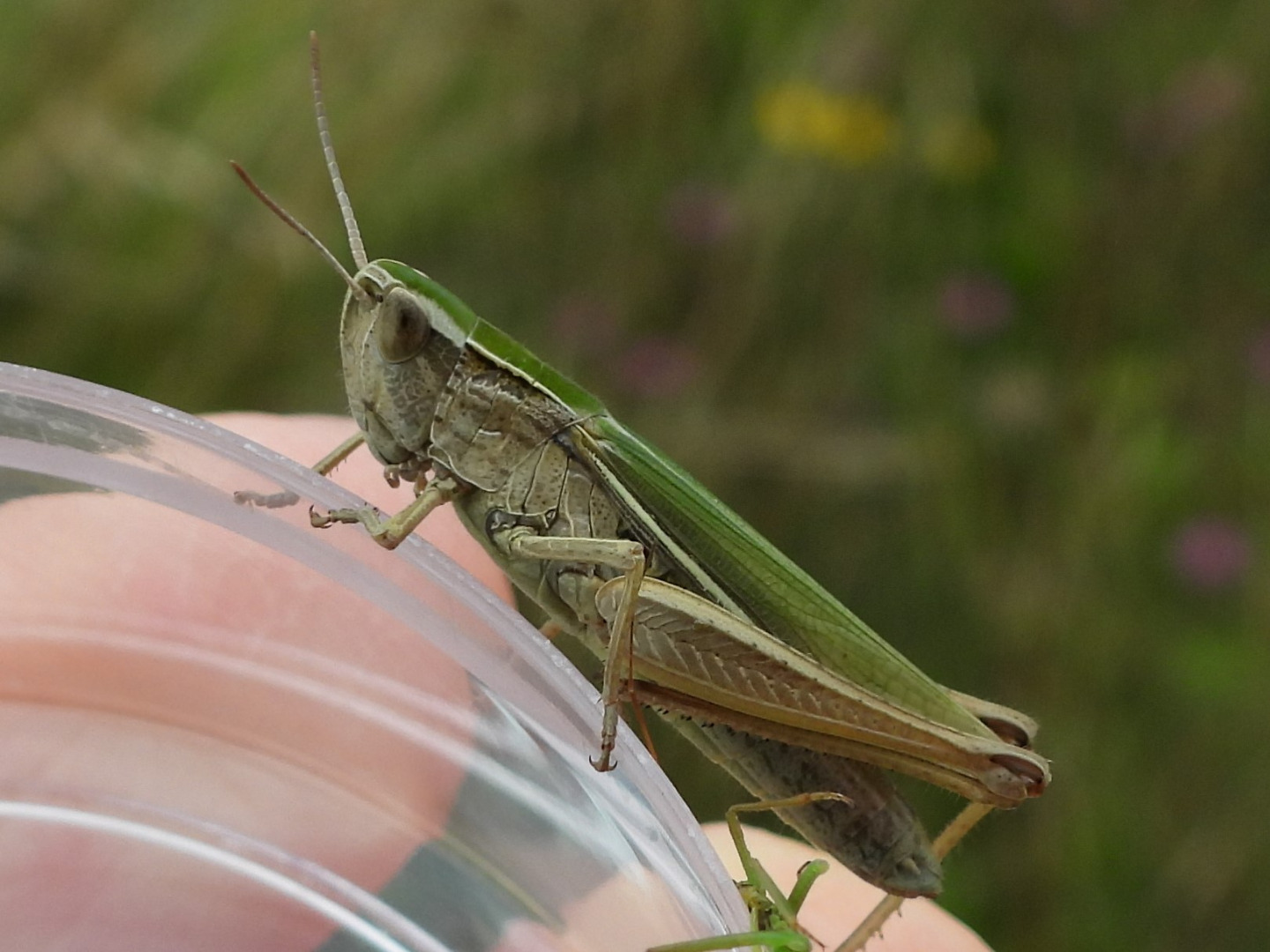 Female Lesser Marsh Grasshopper 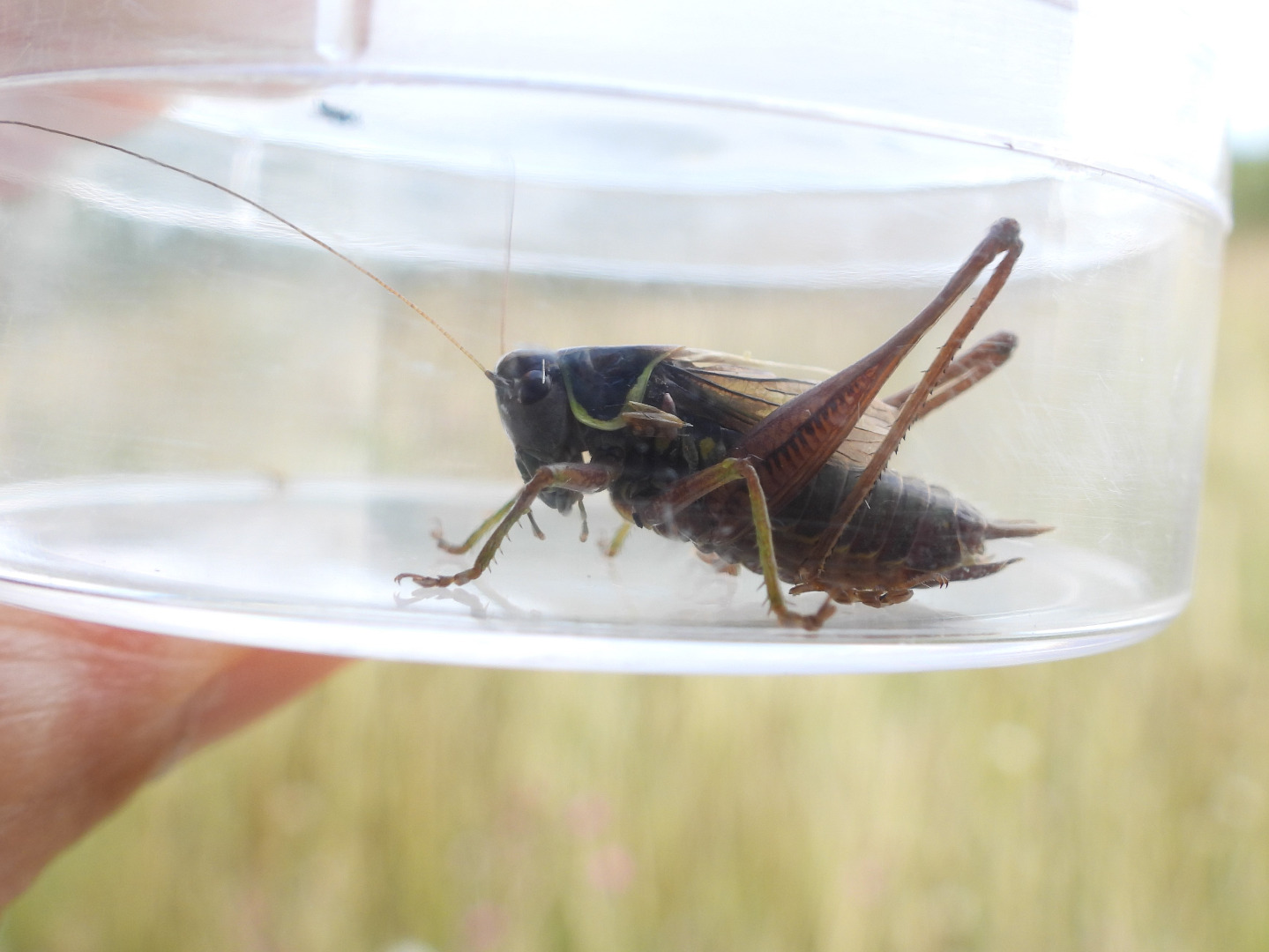 Roesel's Bush-cricket
 The Survey area at Medmerry 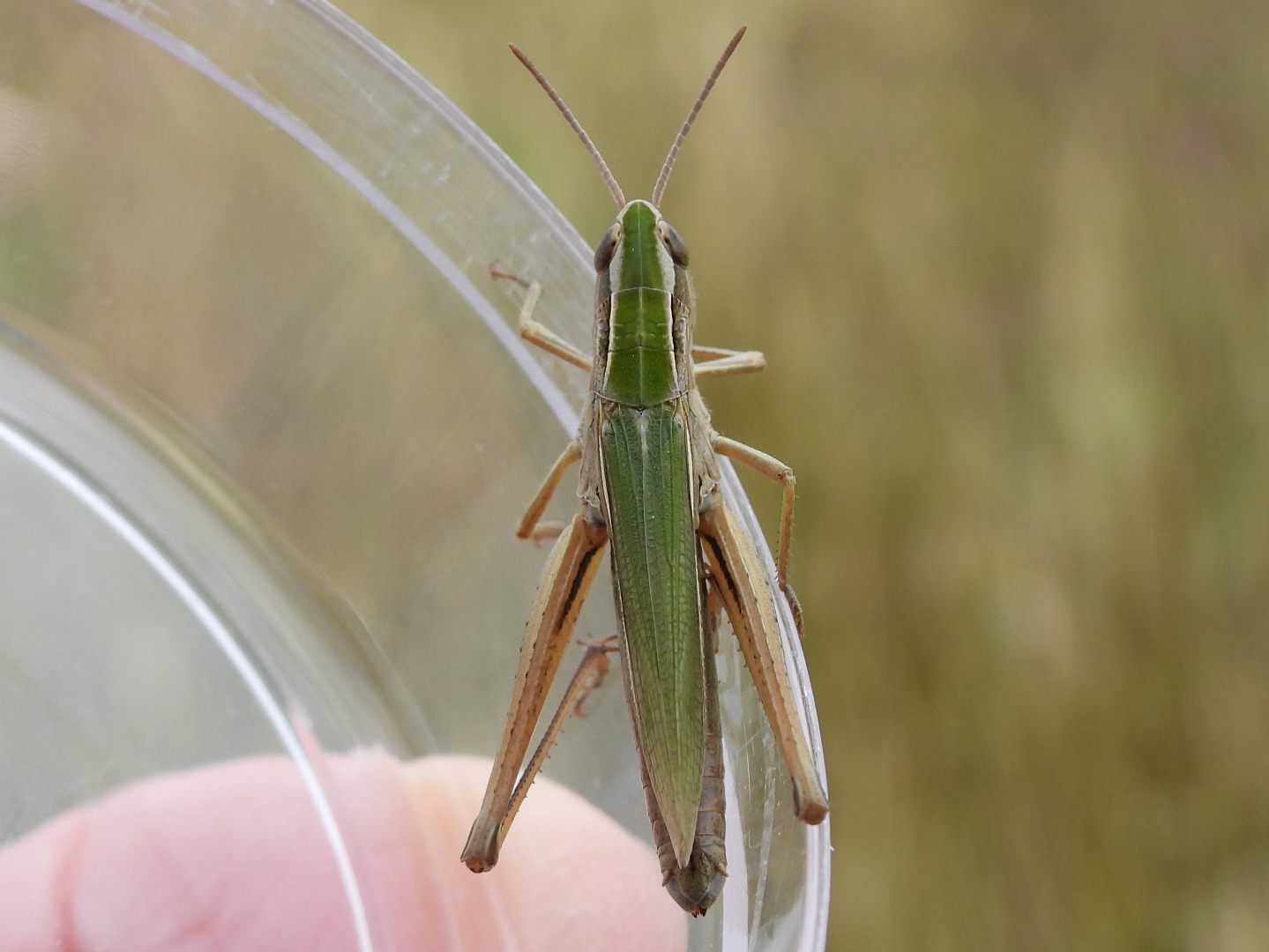 Female Lesser Marsh Grasshopper 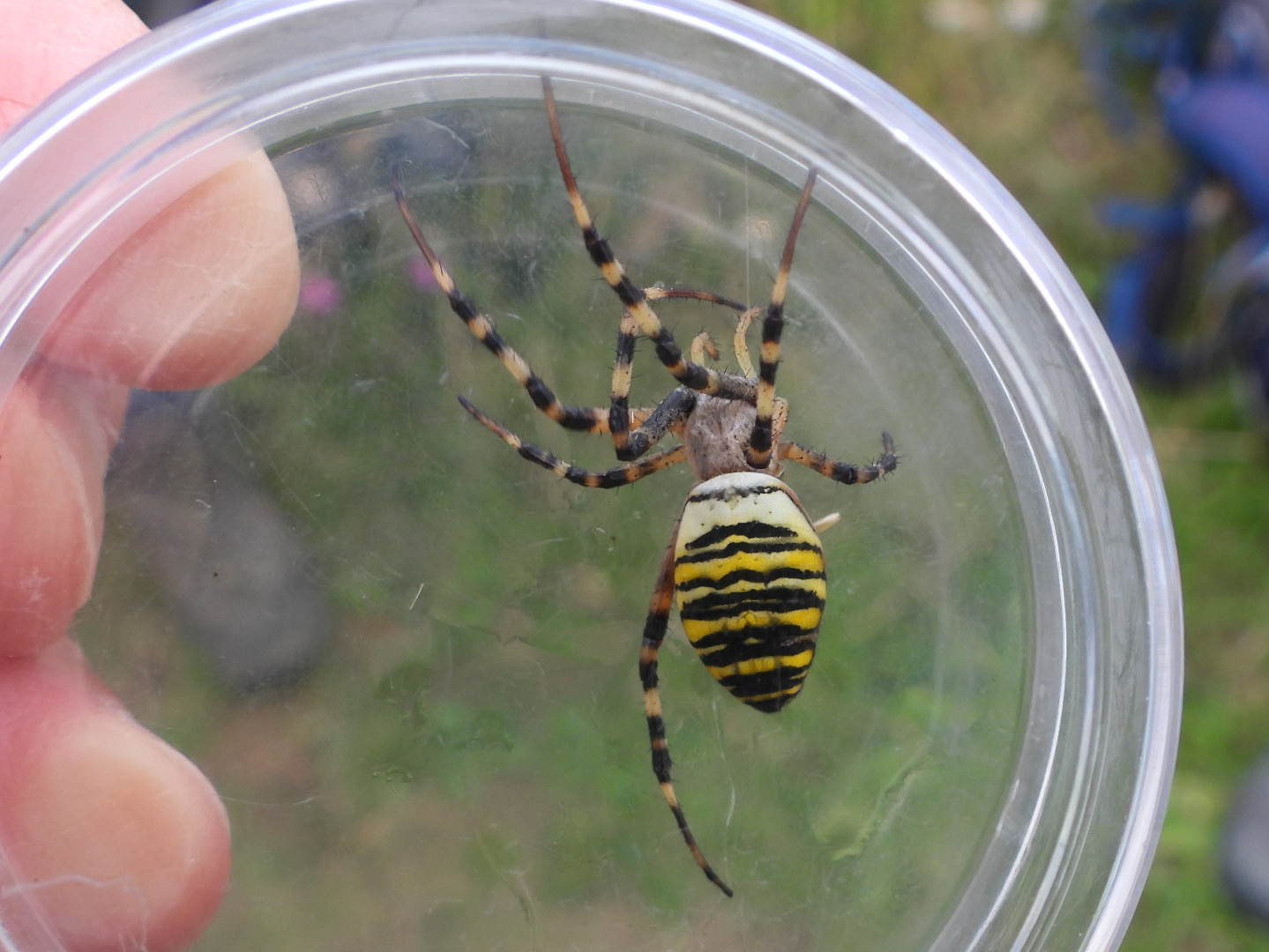 Female Wasp Spider
Medmerry Survey – Early Dragonflies 6 July 2023Inspired by the Society’s Dragonfly walk on Monday July 3rd and with a fine, sunny day in prospect, 9 members attended this survey. This made for more pairs of eyes, binoculars and cameras than usual.
Despite much vegetative growth there were several, if short, stretches of open water where we waited for sightings, particularly inside the ‘gated area’ where it is sometimes difficult.
Each sighting was carefully scrutinized using a range of texts and resources so we hope our identification was correct. It was interesting to note that we saw no male Emperors.
Well done and thanks to all attendees.
Gill Hance
The following species were recorded
Ruddy darter male (4)
Ruddy darter pair in tandem
Blue-tailed damselfly (3)
Blue-tailed damselfly two pairs in tandem
Norfolk hawker (1)
Common darter female (1)
Common blue damselfly pair in tandem
Emperor female ovipositing
Small red-eyed damselfly male
Gill Hance
Other wildlife species seen :
Birds – White throat, Linnet, Skylark, Mediterranean gull, Sand martins,
Swallow, Reed warbler. Sedge warbler (heard).
Butterflies – Gatekeeper, Peacock, Small skipper, 7 spot Burnet moth.
Marsh frog. Grass snake swimming (in first pool).
Carrot, Fleabane and Centaury were in flower 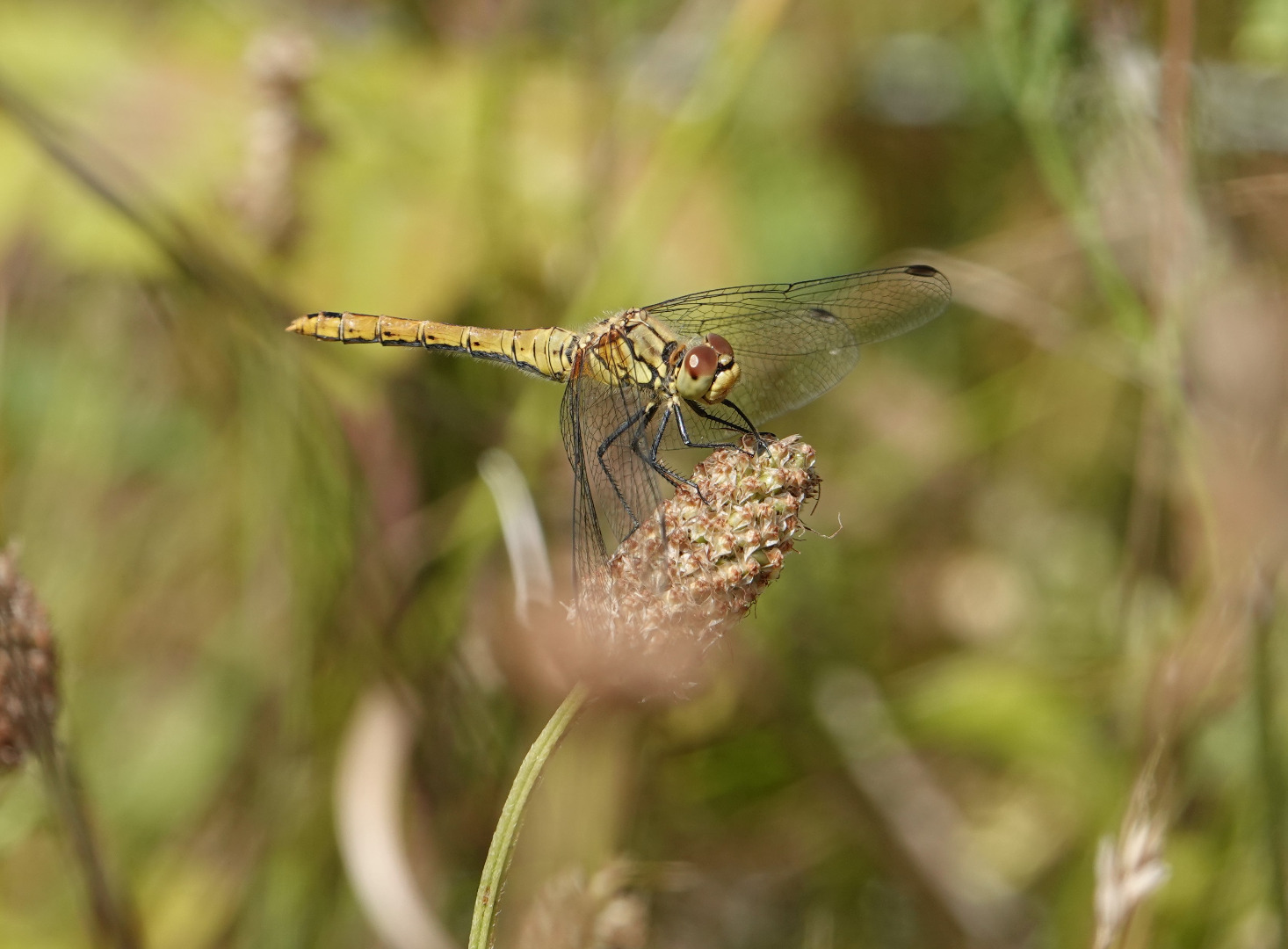 Emperor Dragonfly 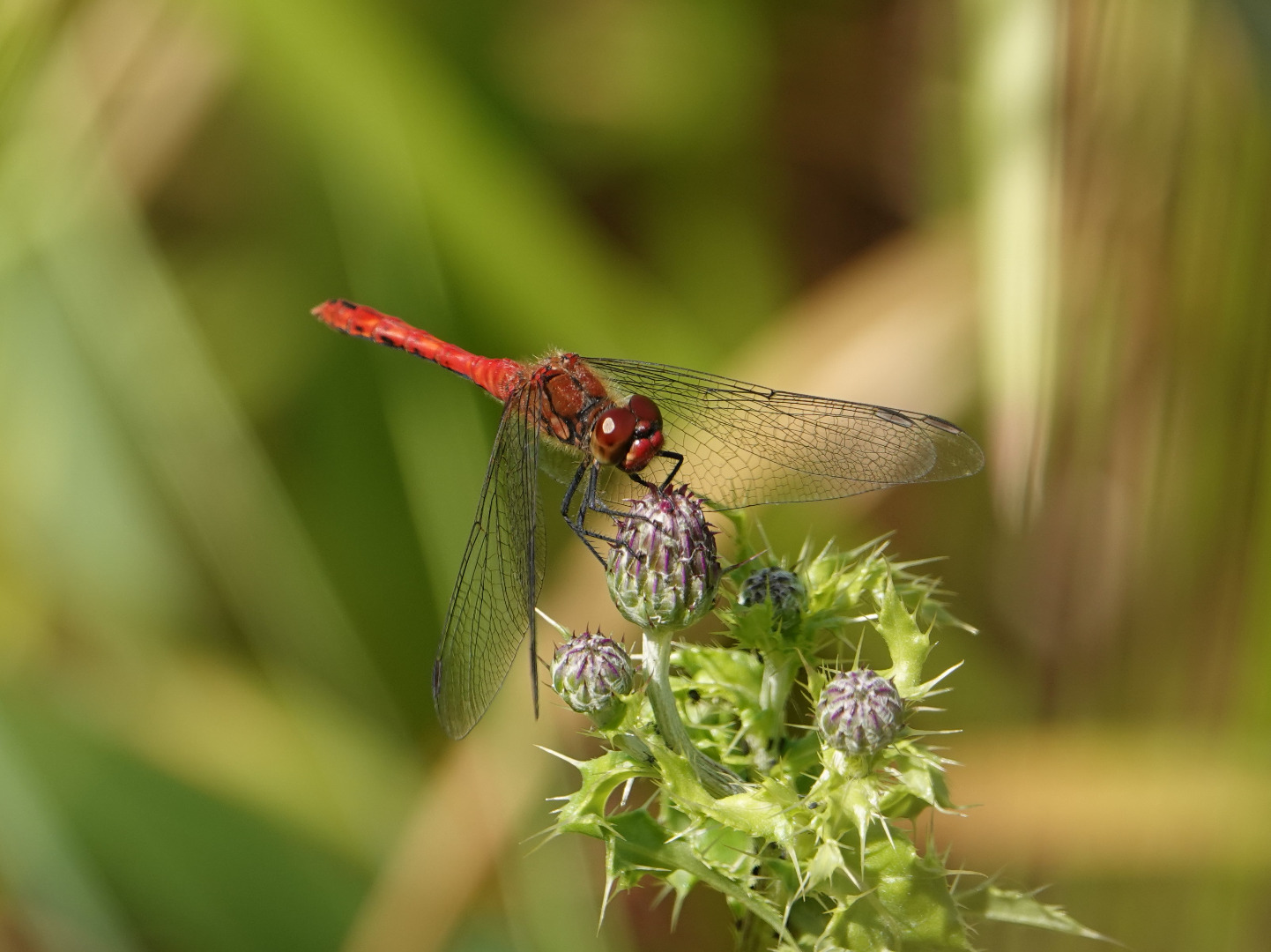 Ruddy Darter 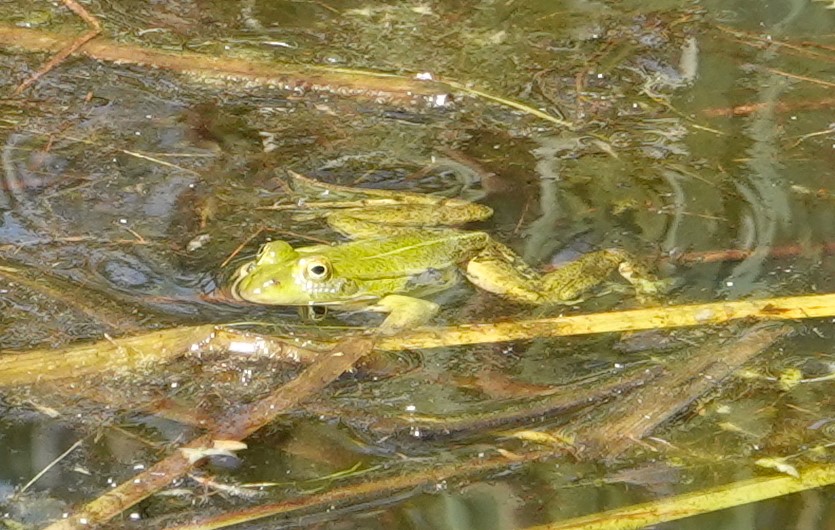 A bonus frog
Medmerry Survey – Botany 2 - quadrats 15 June 2023It was another very warm and humid afternoon for the quadrat survey. Only 4 intrepid surveyors met to do a more detailed survey of the plants on our site. However, the 2 pairs each completed 12 quadrats which collected a good deal of data. Fortunately there was a slight breeze which kept the temperature down slightly but we finished a little early as we had completed sufficient quadrats.
Blackbirds were constantly singing around the area, many Whitethroats were both seen and heard and a group of Linnets flew over. Stock dove was also heard and Cetti’s warblers were belting out their songs from a little distance away. Several Meadow browns were flitting over the bank and 2 or 3 “blue” damselflies were spotted flying fast. These were probably Common blue damselflies.
Well done to all those who worked so hard in somewhat difficult conditions.
Philippa Arnott
Medmerry Survey – Botany 1 - DAFOR 8 June 2023It was a very warm and breezy afternoon when 10 surveyors met to conduct the first survey of the new season. It was great to welcome some members who had not been on a survey before. I do hope they enjoyed it enough to come again!
The surveyors were formed into 3 teams and spread out along the bank to find and record every species present. The plants were looking good with lots of colour, not just Ox-eye daisies.
After some time, as the temperature was rising and it was feeling quite hot, we gathered to discuss our findings and give each species an agreed DAFOR rating (Dominant, Abundant, Frequent, Occasional, Rare). This list will be sent to Helen Dignum who organises the recording and distribution of the data.
Kitty spent some time sweeping for beetles and, I hope, had some success. I spotted a couple of the beautiful metallic green Thick-legged flower beetles on the Ox-eye daisies. Other wildlife seen included several Meadow brown butterflies, a Common blue damselfly, a Silver Y moth (a migrant), a suspected Emperor dragonfly flying very fast in the wind, a group of Linnets flying over and many Buff-tailed bumblebees.
Species heard but not seen included a chorus of Marsh frogs, singing Common Whitethroats and a Blackbird.
It was a most enjoyable afternoon and, we felt, a good start to the season. We are looking forward to next week when the survey will involve using quadrats to look more closely at the identification and distribution of the plants.
Philippa Arnott
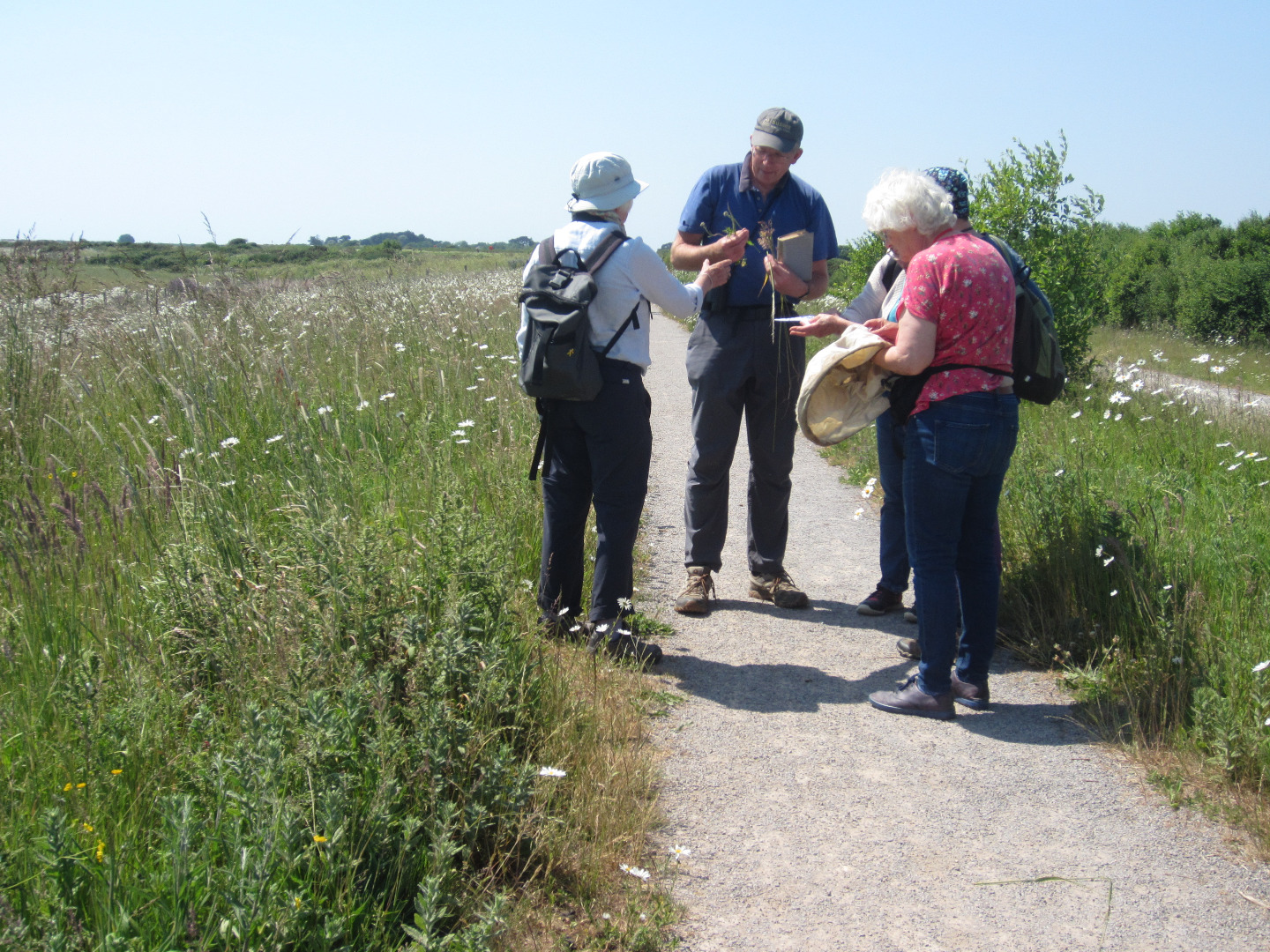 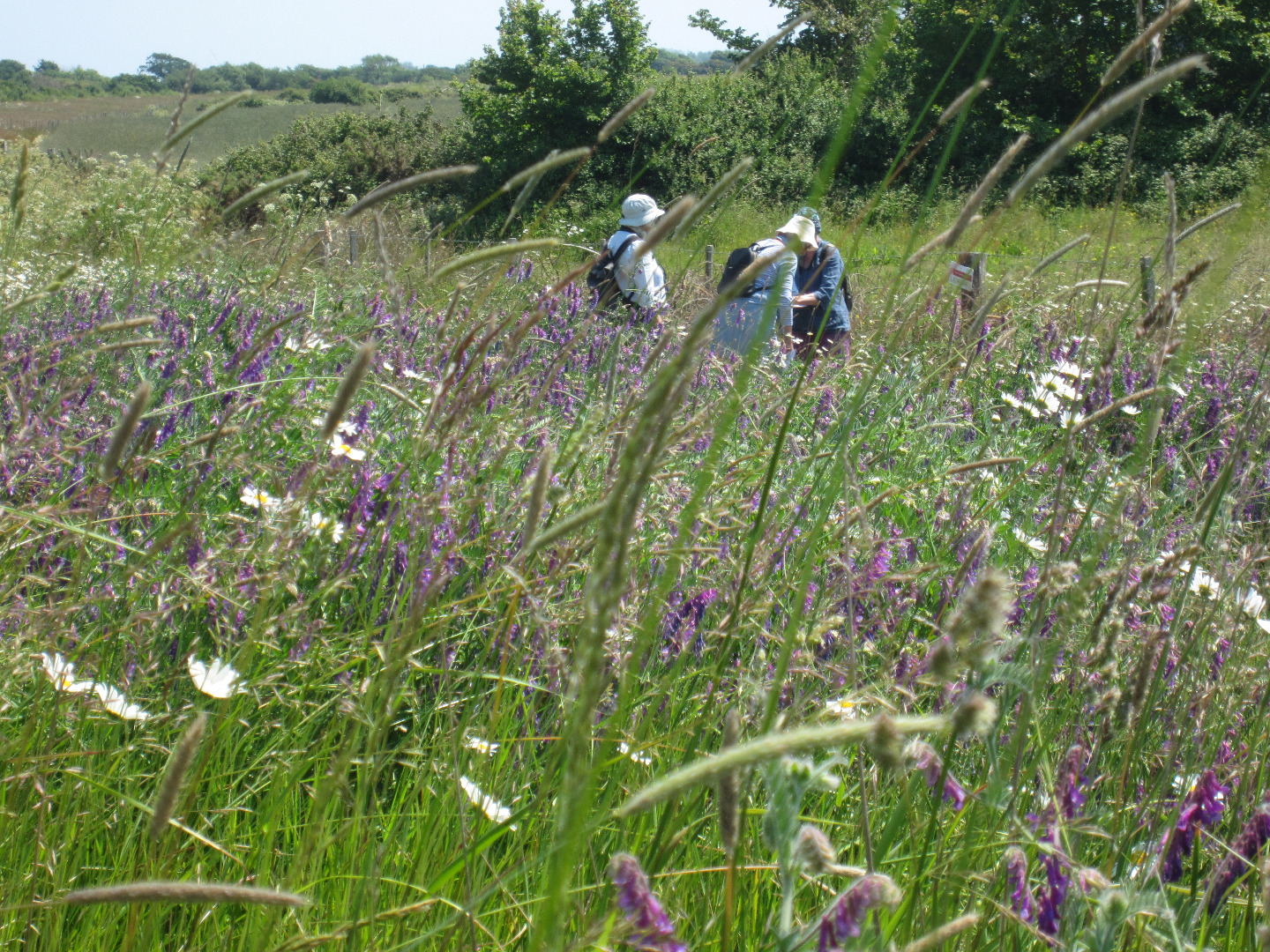
Medmerry Survey – Late Dragonflies 1 September 2022 Medmerry survey 5 – Later Dragonflies 1 September 2022
It was a dry and warm afternoon when 12 members met to find the later flying dragonflies. The temperature was about 24 C, sunny but there was a stiff breeze blowing. This meant that the animals were keeping lower and less easy to see. Nevertheless, 2 Migrant hawkers were soon spotted and several more were seen along the route. Ruddy darter were also in evidence. Two larger dragonflies were spotted over the bank the other side of the track (outside the survey area) but these were too far away to be identified. We expected them to be Southern hawker or Emperor which were conspicuous by their absence.
A juvenile Hobby was seen from the car park and other birds include: Sand martin, Goldfinch, Yellowhammer, Kestrel, Moorhen, Coot, Stock dove, Little egret, Grey heron, Pheasant, Cormorant (flying over) and the sound of Canada geese was a constant backdrop.
Marsh frogs were observed in the pool by the junction where we park. A Painted lady and a Peacock were the only butterflies noted (plus a few unidentified whites) and there were many grasshoppers leaping about our feet.
The total list of dragonflies counted was: 9 Migrant hawker, all male (C)
2 Ruddy darter, male (B)
Many thanks to all the surveyors for their hard work. At least it was pleasantly warm and not hot! A very pleasant afternoon spent in good company and a fitting end to the 2022 season. Here’s to 2023 – our 10th year of surveys!
Philippa Arnott
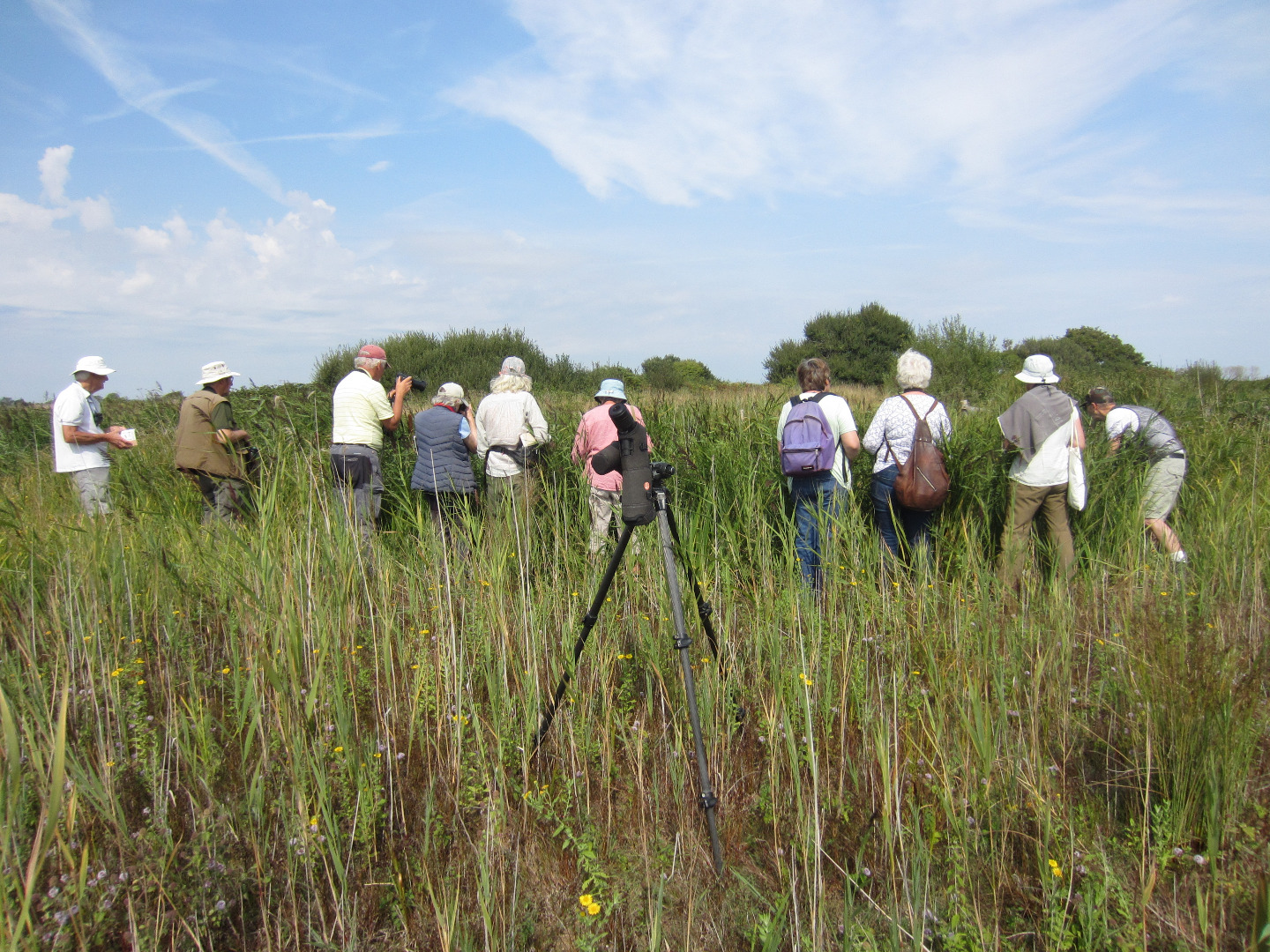 Surveying in the sunshine
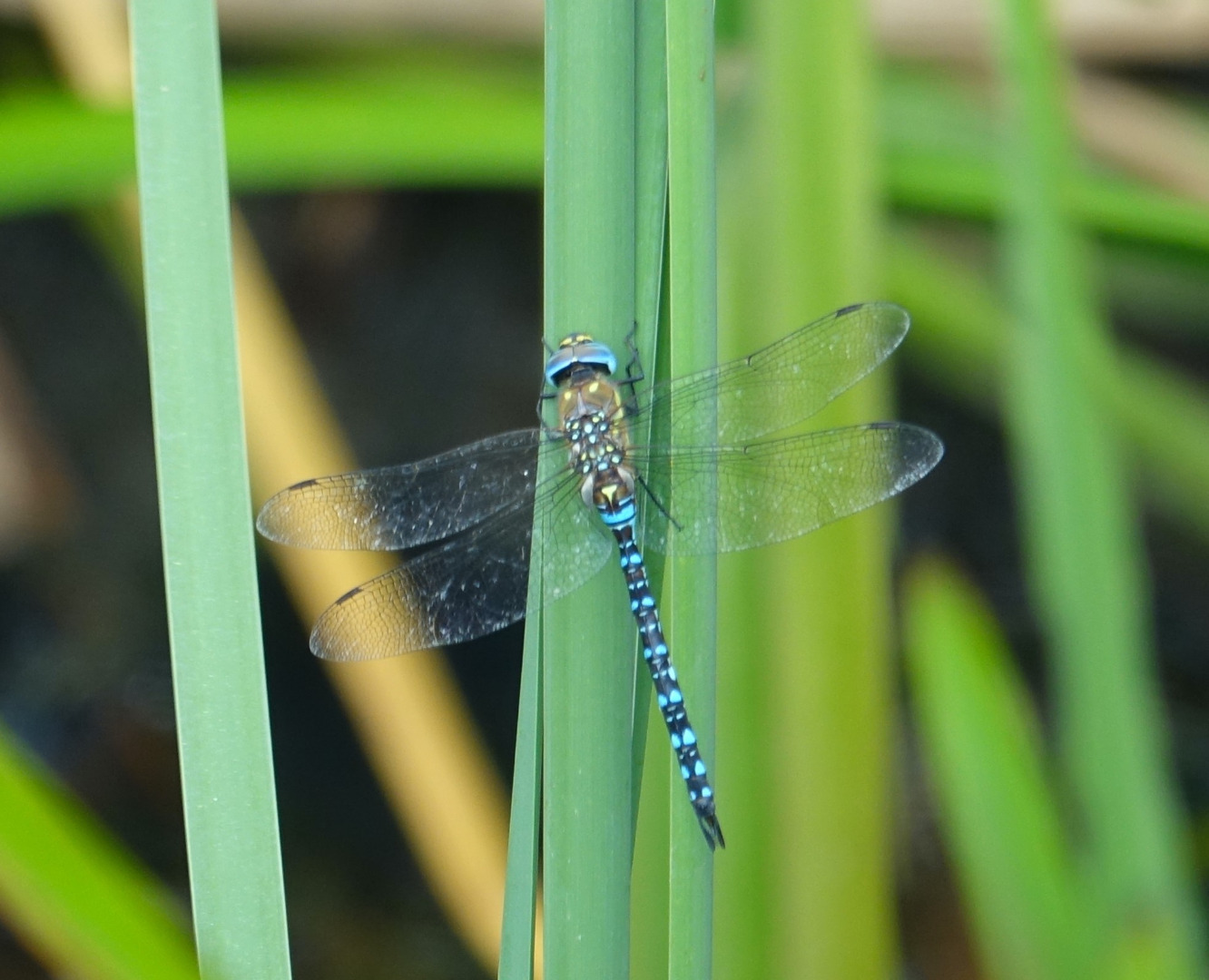 Migrant Hawker 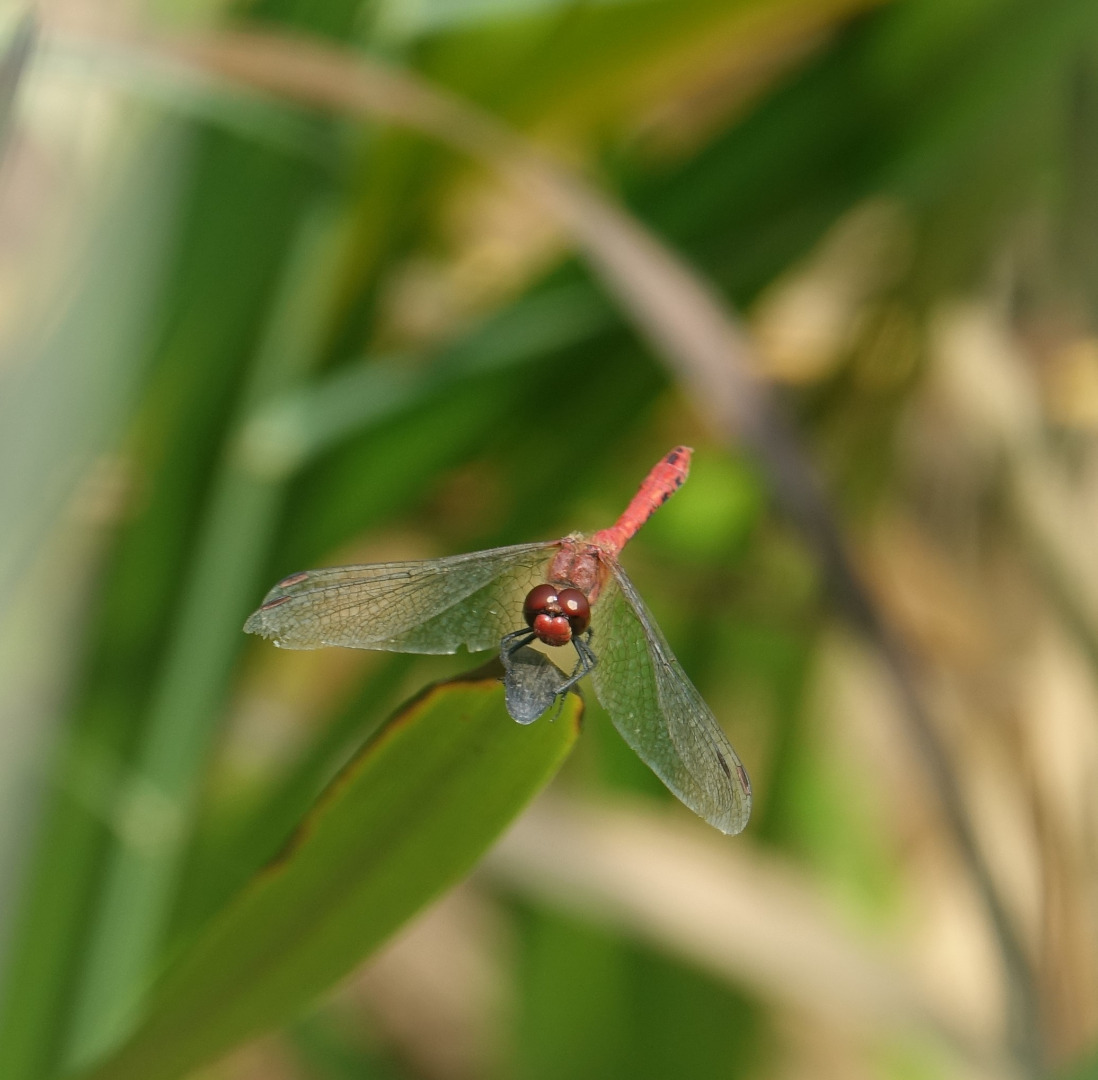 Ruddy Darter 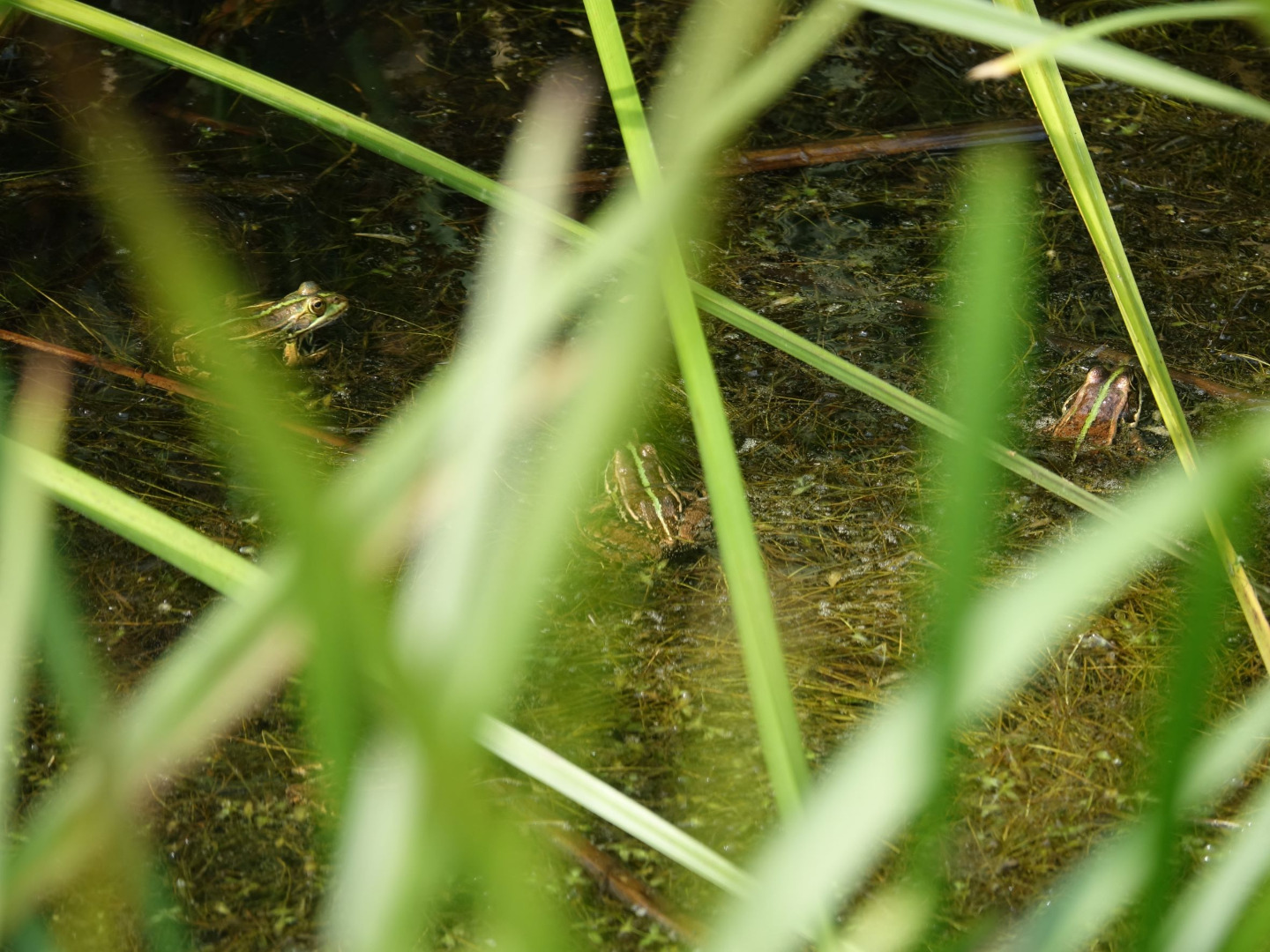 Marsh Frogs
Medmerry Survey – Grasshoppers and Crickets 4 August 2022 It was another warm day when eleven CNHS members and friends met for the Grasshoppers and Bush-crickets survey. The temperature was about 24 C and it was quite windy. On arrival at the site we discovered that the vegetation had grown up considerably since the last survey. Instead of just grasses we were faced with brown, brittle grasses and tall plants such as wild carrot, ragwort and knapweed. There was also fruiting bramble growing low across much of the ground. This made using the nets extremely difficult but there was one area at the far side of the site that had shorter grasses and most animals were caught there. We were pleased to see many grasshoppers all over the site but they were very active and difficult to catch or see closely. It may be that we need to change our modus operandi and learn to identify the grasshoppers using bat detectors, without the need to catch them.
Three species were identified: Lesser marsh grasshopper (4 caught)
Long-winged conehead (1 caught)
Meadow grasshopper (1 caught)
The Lesser marsh has always been the species with most individuals caught.
We were pleased to watch a large number of Swallows flying above us. There were also Goldfinch, 2 Common blue butterflies and a Red-tailed bumblebee.
Thank you to all the team for their efforts in warm and challenging conditions.
Philippa Arnott
p 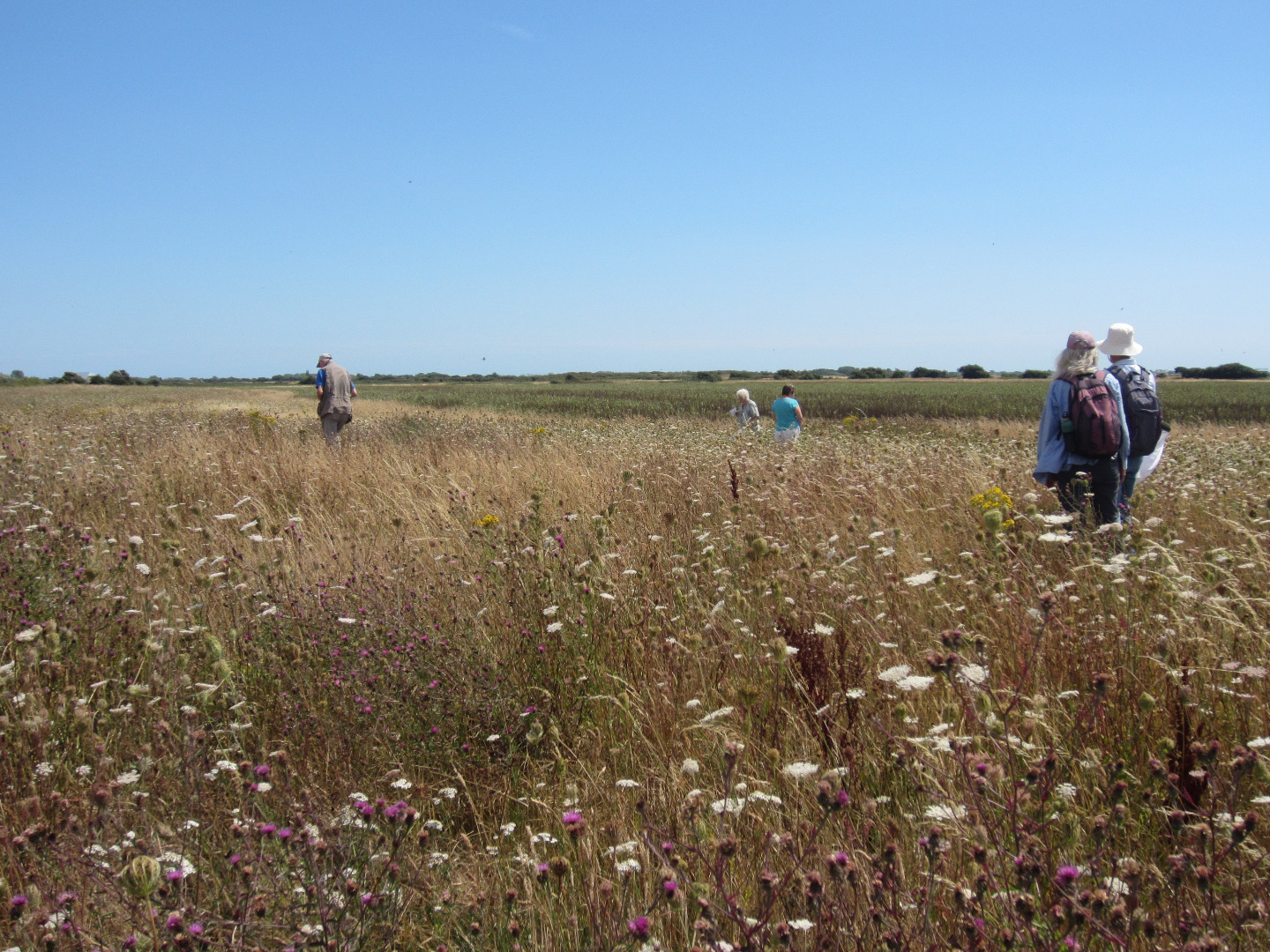 Looking for Grasshoppers 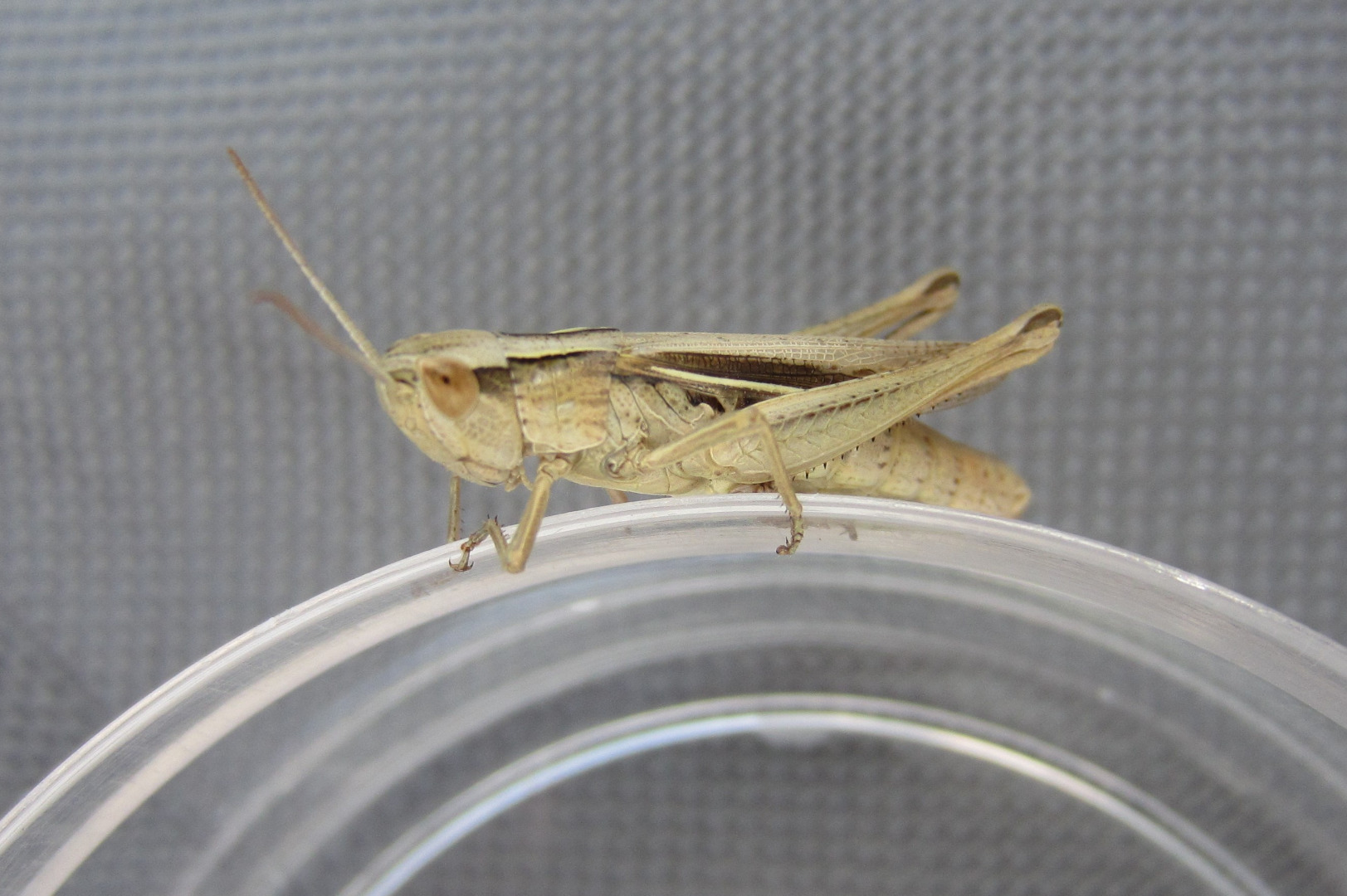 Lesser Marsh Grasshopper

Chichester, West Sussex
|